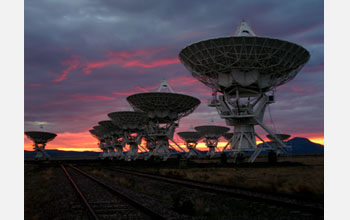Media Advisory 09-031 - Audio
Anthony Remijan discusses how the first constituents for life could be found in outer space.
This material is available primarily for archival purposes. Telephone numbers or other contact information may be out of date; please see current contact information at media contacts.

Anthony Remijan, an assistant scientist with the National Radio Astronomy Observatory, discusses how the first constituents for life could be found in outer space.
Credit: Audio by Kevin Norris/National Science Foundation; image by Dave Finley, NRAO/AUI/NSF
Audio Transcript: BOBBIE MIXON: The first person to propose a truly plausible idea for the start of life on Earth was Charles Darwin. In a letter to his friend and botanist, Joseph Hooker, Darwin wrote, "It is often said that all the conditions for the first production of a living organism are present which could ever have been present." But a group of scientists, astrochemists, like the National Radio Astronomy Observatory's Dr. Anthony Remijan, are compiling evidence that suggest all the necessary conditions may not have been present on Earth. Instead, they may have been present in outer space. Dr. Remijan, welcome. DR. ANTHONY REMIJAN: Thank you for having me. Appreciate it. BOBBIE MIXON: Why do you think Earth wasn't a suitable environment for life's first molecules? DR. ANTHONY REMIJAN: Right now, we know that Earth is very good at supporting life but when Earth was first forming and you had to synthesize prebiotic organic molecules, the molecules that build up our--what goes into RNA, which, you know, are a bunch of proteins and amino acids, the constituents of the early Earth's atmosphere did not have the necessary reactons in order to form these large prebiotic molecules. What we're finding is that more and more evidence is suggesting that the early Earth had a very oxidizing atmosphere, which precludes the formation of large organic molecules and what you need is a highly reducing atmosphere, which is very rich in hydrogen molecules and hydrogen atoms in order to drive the chemistry necessary to form large prebiotic molecules. BOBBIE MIXON: Are you saying it's unlikely that the amino acids needed to produce RNA and DNA could've formed right here on Mother Earth? DR. ANTHONY REMIJAN: That's one thing that we are suggesting, that the conditions on the early Earth were not conducive to this type of chemistry but it was possible that the chemistry could've been transported to the early Earth by comets, meteorites, asteroids that have the chemistry bottled up from the interstellar medium, from interstellar space that brought this chemistry to early planets like the early Earth. BOBBIE MIXON: You make the point that the large molecules found in outer space are very simple compared to RNA and very simple compared to the amino acids needed for RNA. What are the chances that the necessary precursors to RNA could be found somewhere in our solar system, or beyond? DR. ANTHONY REMIJAN: Well, it is possible that these molecules already exist out in space but they're just below our detection limit. No matter what we do as scientists, we can only build an instrument so sensitive before we reach either the observational limit of where we're observing at, either we're observing on the Earth or if we go out into outer space, we eventually reach a physical limit to our technology, it may be then the next 50, 100 years our technology has advanced to a point where we could detect these molecules floating around in space but as of right now, we just can't see them because they currently lie below our detection limit. BOBBIE MIXON: But you also say we now know there's a chemistry in outer space producing molecules from vinegar to antifreeze. Vinegar to antifreeze? DR. ANTHONY REMIJAN: That's exactly correct. So, molecules that are ... you could go into your common household, you know, cabinets and pick them out. Vinegar, you know, acetic acid. We've detected acetic acid now in many different sources throughout the galaxy. It's a relatively simple molecule but it is out there and it's formed in space in relatively high abundance. The same thing with ethylene glycol, which is what's found in antifreeze. You go out in your garage, you won't be able to drive to work if you didn't have antifreeze in your car but interstellar antifreeze was detected relatively easily and we have ... and there's a lot of it floating around in space. BOBBIE MIXON: Darwin gave the world evolution through the process of natural selection. Do you think there's a preferred natural selection that leads to the formation of larger molecules, such as amino acids, in outer space? DR. ANTHONY REMIJAN: Well, I think there is definitely a preferred formation pathway to molecules out in space, and we don't fully understand its chemistry yet because our limit ... we have a limited sample of where these molecules are found in space and in what condition these molecules are found in space. It's only a matter of time as we take more and more data with the new telescopes coming online, for example, the expanded very large ray in New Mexico or the Atacama large-millimeter ray in Chile. When we have these telescopes online and we can do large surveys in a lot of different environments for these large molecules, we could get a better understanding of the chemistry that went into the formation of these molecules. BOBBIE MIXON: That's Dr. Anthony Remijan with the National Radio Astronomy Observatory in Charlottesville, Virginia. Thanks for joining us. DR. ANTHONY REMIJAN: Thank you very much.

This video requires the free Windows Media Player plug-in


